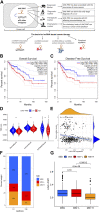Clinical implications of lncRNA LINC-PINT in cancer
- PMID: 37006616
- PMCID: PMC10064087
- DOI: 10.3389/fmolb.2023.1097694
Clinical implications of lncRNA LINC-PINT in cancer
Abstract
Long noncoding RNAs (lncRNAs) possess the potential for therapeutic targeting to treat many disorders, including cancers. Several RNA-based therapeutics (ASOs and small interfering RNAs) have gained FDA approval over the past decade. And with their potent effects, lncRNA-based therapeutics are of emerging significance. One important lncRNA target is LINC-PINT, with its universalized functions and relationship with the famous tumor suppressor gene TP53. Establishing clinical relevance, much like p53, the tumor suppressor activity of LINC-PINT is implicated in cancer progression. Moreover, several molecular targets of LINC-PINT are directly or indirectly used in routine clinical practice. We further associate LINC-PINT with immune responses in colon adenocarcinoma, proposing the potential utility of LINC-PINT as a novel biomarker of immune checkpoint inhibitors. Collectively, current evidence suggests LINC-PINT can be considered for use as a diagnostic/prognostic marker for cancer and several other diseases.
Keywords: Cancer biomarkers; Cancer therapy; Colon adenocarcinoma (CAC); Immune checkpoint inhibitors; LINC-PINT; LncRNA; PINTology.
Copyright © 2023 Bukhari, Khan, Li, Swiatczak, Thorne, Zheng and Mi.
Conflict of interest statement
The authors declare that the research was conducted in the absence of any commercial or financial relationships that could be construed as a potential conflict of interest.
Figures


Similar articles
-
PINTology: A short history of the lncRNA LINC-PINT in different diseases.Wiley Interdiscip Rev RNA. 2022 Jul;13(4):e1705. doi: 10.1002/wrna.1705. Epub 2022 Jan 12. Wiley Interdiscip Rev RNA. 2022. PMID: 35019222 Review.
-
Long intragenic non-coding RNA p53-induced transcript (LINC-PINT) as a novel prognosis indicator and therapeutic target in cancer.Biomed Pharmacother. 2021 Nov;143:112127. doi: 10.1016/j.biopha.2021.112127. Epub 2021 Aug 30. Biomed Pharmacother. 2021. PMID: 34474342 Review.
-
Downregulation of long non-coding RNA LINC-PINT serves as a diagnostic and prognostic biomarker in patients with non-small cell lung cancer.Oncol Lett. 2021 Mar;21(3):210. doi: 10.3892/ol.2021.12471. Epub 2021 Jan 18. Oncol Lett. 2021. PMID: 33552292 Free PMC article.
-
LncRNA Linc-PINT inhibits miR-523-3p to hamper retinoblastoma progression by upregulating Dickkopf-1 (DKK1).Biochem Biophys Res Commun. 2020 Sep 10;530(1):47-53. doi: 10.1016/j.bbrc.2020.06.120. Epub 2020 Jul 29. Biochem Biophys Res Commun. 2020. PMID: 32828314
-
Functional Mechanism and Clinical Implications of lncRNA LINC-PINT in Delayed Fracture Healing.J Invest Surg. 2024 Dec;37(1):2421826. doi: 10.1080/08941939.2024.2421826. Epub 2024 Oct 28. J Invest Surg. 2024. PMID: 39467565
Cited by
-
Lnc-PTCHD4-AS inhibits gastric cancer through MSH2-MSH6 dimerization and ATM-p53-p21 activation.Aging (Albany NY). 2023 Nov 27;15(22):13558-13578. doi: 10.18632/aging.205329. Epub 2023 Nov 27. Aging (Albany NY). 2023. PMID: 38016120 Free PMC article.
-
LINC01134: a pivotal oncogene with promising predictive maker and therapeutic target in hepatocellular carcinoma.Front Oncol. 2024 Feb 21;14:1265762. doi: 10.3389/fonc.2024.1265762. eCollection 2024. Front Oncol. 2024. PMID: 38450182 Free PMC article. Review.
-
m6A- and m5C- modified lncRNAs orchestrate the prognosis in cutaneous melanoma and m6A- modified LINC00893 regulates cutaneous melanoma cell metastasis.Skin Res Technol. 2024 Jul;30(7):e13842. doi: 10.1111/srt.13842. Skin Res Technol. 2024. PMID: 38965799 Free PMC article.
-
Association of long non-coding RNAs and ABO blood groups with acute lymphoblastic leukemia in Egyptian children.Noncoding RNA Res. 2024 Jan 18;9(2):307-317. doi: 10.1016/j.ncrna.2024.01.010. eCollection 2024 Jun. Noncoding RNA Res. 2024. PMID: 38505304 Free PMC article.
-
Co-Expression Network Analysis Unveiled lncRNA-mRNA Links Correlated to Epidermal Growth Factor Receptor-Tyrosine Kinase Inhibitor Resistance and/or Intermediate Epithelial-to-Mesenchymal Transition Phenotypes in a Human Non-Small Cell Lung Cancer Cellular Model System.Int J Mol Sci. 2024 Mar 29;25(7):3863. doi: 10.3390/ijms25073863. Int J Mol Sci. 2024. PMID: 38612674 Free PMC article.
References
-
- Bi X., Guo X. H., Mo B. Y., Wang M. L., Luo X. Q., Chen Y. X., et al. (2019). LncRNA PICSAR promotes cell proliferation, migration and invasion of fibroblast-like synoviocytes by sponging miRNA-4701-5p in rheumatoid arthritis. EBioMedicine 50, 408–420. 10.1016/j.ebiom.2019.11.024 - DOI - PMC - PubMed
Grants and funding
LinkOut - more resources
Full Text Sources
Research Materials
Miscellaneous

